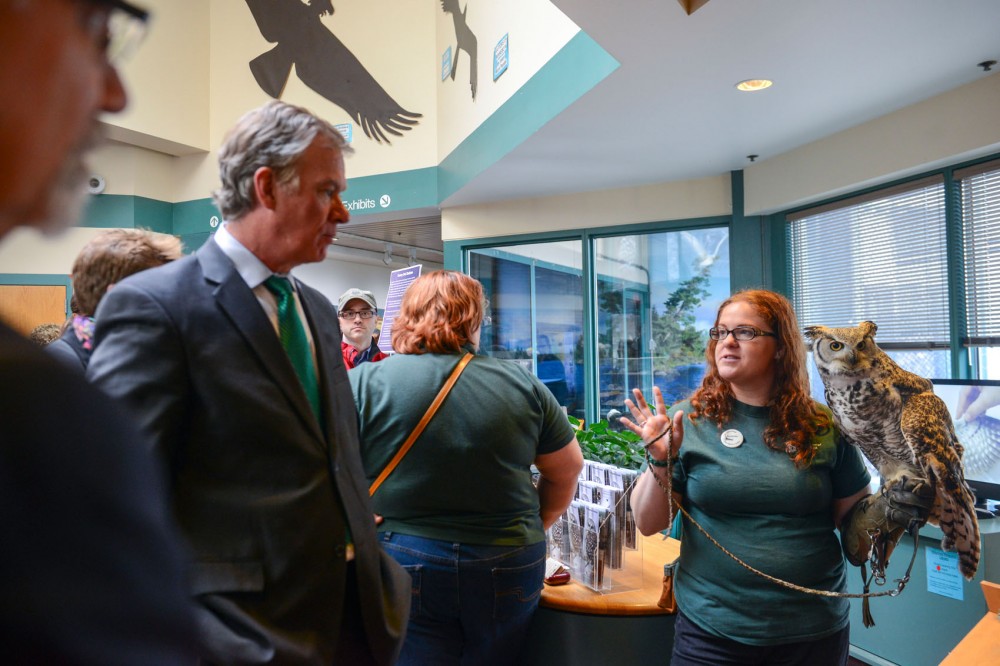Ellen Andersen has been coming to the University of Minnesota’s Raptor Center for more than 25 years, and her family has been donating to the center for more than 30.
The center was a regular stop on her family’s visits to the city — trips that also included the Science Museum of Minnesota and the Minnesota Children’s Museum, she said.
Donors like Andersen have helped the center raise nearly $4.6 million dollars to operate for the next three years, including $1.5 million for a renovation.
Established in 1974 as part of the University of Minnesota’s College of Veterinary Medicine and located on the University’s St. Paul campus, the Raptor Center cares for sick and injured raptors, including eagles, falcons and owls.
The center is open to the public and gets nearly 20,000 visitors annually.
On April 24, about 50 people attended a groundbreaking ceremony to celebrate the center’s 40th anniversary and see plans for the renovation, which will begin this summer and likely be completed by the winter.
Raptor Center Executive Director Julia Ponder said the changes include updating holding facilities for the birds and redesigning the educational area, which is currently tucked into a hillside. The new design will reorient the educational facility so it’s easier to maintain and more accessible for people with disabilities, she said.
Education Program Manager Gail Buhl said the renovation will benefit visitors and employees alike.
In its current state, the pathway in the educational area is narrow and in disrepair, she said, and there’s no roof to shield visitors from the weather — conditions that can be dangerous for both staff and visitors.
Staff members are constantly dealing with rain, snow or ice, she said.
“In the winter time, we are shoveling … chopping ice and putting down ice melt and putting down sand,” she said. “It’s a constant fight.”
The new facility will have covered walkways, Buhl said, which should give staff more time to dedicate to programs instead of working on maintenance issues.
The current wooden holding pens for the birds are more than 20 years old and beginning to rot, she said, so they plan to replace them with newer, more durable materials that are easier to clean.
The renovations will allow the center to care for more birds, said Clinic Manager Lori Arent, and make the center more “bird-friendly.” Each year, the center rehabilitates more than 900 raptors, including eagles, owls, falcons and hawks.
While the renovation won’t add any square footage, the new layout will maximize facility space to increase the total number of holding and flight pens, she said, which could help speed up recovery time for birds. They’ll also remove the old mesh netting from the pens because it can sometimes injure birds’ claws or tail feathers if they get frightened or stuck, Arent said.
Buhl said the new layout will also ease congestion inside the center.
“We’re a small building and actually a pretty small space,” she said. “And we do pretty darn well for 20,000 people coming here every year already. But we’re going to make it better.”
Looking ahead‘40 years later’
Co-founder and Director Emeritus Patrick Redig remembers attending the Raptor Center’s first groundbreaking ceremony in 1974.
Back then, he said, he never expected the center would come this far.
“To be sitting here today 40 years later, first of all, is just an amazing thing,” he said, “really an auspicious thing.”
The center is a nonprofit organization meant to serve the community, and Redig said he’s “thrilled” to see the community continue to support it with new facilities that should last another 20 to 30 years.
Growing up in Bayport, Minn., Andersen said she witnessed firsthand the decline of peregrine falcons because of DDT, a pesticide commonly used before it was banned in 1972.
Supporting the Raptor Center was important to her family and their community, Andersen said, because it helped play a role in recovering falcons. The U.S. Fish and Wildlife Service removed the peregrine falcon from the endangered species list in 1999.
Raptor Center advisory board member Rachel Hollstadt said she’s been visiting the center for about a decade, and she learns something new each time.
“There’s just so many stories,” she said. “These are the things why it’s fun to be here.”


